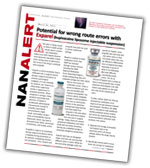This alert is based on information from the National Medication Errors Reporting Program operated by the Institute for Safe Medication Practices.
Potential for Wrong Route Errors With Exparel (bupivacaine liposome injectable suspension)
This alert is being issued to inform health professionals about a potential medication safety issue with Exparel (bupivacaine liposome injectable suspension): wrong route of administration errors if the drug is confused with propofol.
Exparel is a local anesthetic that is infiltrated into a surgical wound during a surgical procedure to produce postsurgical analgesia. It is not intended for systemic use. Exparel is a milky white suspension similar in appearance to propofol emulsion. When prepared in syringes, these products essentially look identical. If Exparel is accidentally administered intravenously instead of propofol, toxic blood concentrations might result, and cardiac conductivity and excitability may be depressed, which may lead to atrioventricular block, ventricular arrhythmias, and cardiac arrest.
Propofol is used as an anesthetic during surgical procedures and as a sedative during procedures or for patients undergoing mechanical ventilation. Thus, Exparel and propofol may both be used in similar healthcare settings.
Based on analysis of other medication errors that ISMP has received through various sources, including the ISMP NationalMedication Errors Reporting Program, similar looking drug vials and unlabeled syringes are often identified as root causes of medication errors. There is reason to believe such mixups are possible with Exparel and propofol. The concern about unlabeled syringes is well founded in this case, as some practitioners in the operative setting have long held the now false belief that propofol is the only white milky parenteral medication one sees in surgical settings. Today, there are several parenteral medications and other fluids that are white emulsions, leaving any unlabeled syringe an extremely dangerous proposition.
Exparel vials have an elongated shape and neck size and may feel different when in hand.While the teal and white package colors are specific to Exparel, some propofol vials also have teal and white colors or blue and white colors that may be difficult to differentiate from an Exparel teal label, especially in poorly lit areas or by individuals who have difficulty perceiving certain colors. The 20 mL volume of Exparel vials is similar to that of some propofol vials. A bold statement that Exparel is for infiltration only appears on the label but may not be noticed by all users.
To date, neither ISMP nor FDA has received any medication error reports of mix-ups between Exparel and propofol. Therefore, this NAN alert is intended to help healthcare facilities preempt serious medication errors by implementing these recommendations wherever both products may coexist:
- Separate the storage of propofol and Exparel vials in the pharmacy and in all clinical settings where the drugs may be stocked.
- Specifically remind staff to never leave any syringe of medication or solution unlabeled. The general rule for safety is to label any prepared syringe or solution if it is not administered immediately or if it may leave the preparer’s hands. However, the high risk of mixups between unlabeled syringes of propofol and Exparel and the subsequent risk of patient harm suggest that more stringent precautions are needed with these 2 medications. In the operating room or in other surgical areas where Exparel and propofol may both be used, all syringes of these medications prepared by a scrub nurse, circulating registered nurse, anesthesia staff, or surgeon should be labeled, even if the medication will be immediately administered (propofol) or infiltrated into the surgical site (Exparel).
- As an added precaution, the circulating registered nurse should establish a routine double check to make sure any unused medication in a syringe containing Exparel never leaves the sterile field without a label.
- To facilitate proper labeling within a sterile field, hospitals should provide sterile labels to affix to prepared syringes of all medications.
- It is dangerous to leave an unlabeled syringe of any drug on a counter, in a cart drawer, or anywhere else. If found, the contents of any unlabeled syringe should be discarded immediately.
- For patient safety, hospital medication labeling practices should be subject to ongoing monitoring.
- Immediately distribute this alert to healthcare practitioners, particularly those who work in surgical settings such as operating room nurses, pharmacists, anesthesia staff, and surgeons.
- Ensure that directions for treatment of bupivacaine toxicity are readily available in all surgical areas where Exparel may be used. A helpful checklist for the treatment of local anesthetic system toxicity can be found at: www.asra.com/checklist-forlocal-anesthetic-toxicity-treatment-1-18-12.pdf. The organization that provides this checklist, the American Society of Regional Anesthesia and Pain Medicine, also suggests making a local anesthetic toxicity kit available in key areas.
The National Alert Network (NAN) is a coalition of members of the National Coordinating Council on Medication Error Reporting and Prevention (NCCMERP). The network, in cooperation with the Institute for Safe Medication Practices (ISMP) and the American Society of Health-System Pharmacists (ASHP), distributes NAN alerts to warn healthcare providers of the risk for medication errors that have caused or may cause serious harm or death. NCCMERP, ISMP, and ASHP encourage the sharing and reporting of medication errors both nationally and locally, so that lessons learned can be used to increase the safety of the medication use system.


 Issue PDF
Issue PDF